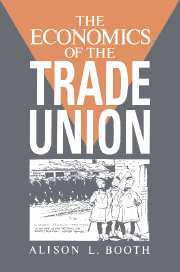Book contents
- Frontmatter
- Contents
- List of figures
- List of tables
- Preface
- 1 Introduction
- 2 The development of the union movements of Britain and the United States
- 3 The orthodox theoretical framework: an overview
- 4 Trade union objectives and the monopoly union model
- 5 Bargaining models of the trade union
- 6 Empirical estimates of the union wage differential
- 7 The impact of trade unions on productivity, investment, profitability, employment and hours
- 8 Unions and the macroeconomy
- 9 Conclusion
- References
- Index
5 - Bargaining models of the trade union
Published online by Cambridge University Press: 07 October 2009
- Frontmatter
- Contents
- List of figures
- List of tables
- Preface
- 1 Introduction
- 2 The development of the union movements of Britain and the United States
- 3 The orthodox theoretical framework: an overview
- 4 Trade union objectives and the monopoly union model
- 5 Bargaining models of the trade union
- 6 Empirical estimates of the union wage differential
- 7 The impact of trade unions on productivity, investment, profitability, employment and hours
- 8 Unions and the macroeconomy
- 9 Conclusion
- References
- Index
Summary
Introduction
The previous chapter examined the modelling of trade union preferences and managerial preferences, and a method of reconciliation of these preferences – the monopoly union model. In the monopoly union model, the labour union is assumed to have the power to impose its preferred wage policy on the firm, which then determines employment from its labour demand curve. While some researchers have argued that this model is a reasonable approximation for particular industries at particular times (for example, the US bituminous coal industry over the period 1948 to 1973 (Farber, 1978b, 1978c)), observation suggests that wages are more frequently bargained over by trade unions and management. Once it is assumed that wages are determined by bargaining between labour and management, we need to add to the model of the previous chapter a means of determining a solution to the bargaining process. When the firm and the union are bargaining over wages, they are in a bilateral monopoly situation, in which a single seller of labour confronts a single buyer. There is a single seller of labour in that the union controls the supply of labour to the firm, and nonunion workers cannot be easily or costlessly substituted by the firm for union workers. There is effectively also a single buyer of labour; if the firm locks out, or dismisses workers, they face costs in moving to another job, lost specific training investments, and perhaps the prospect of being unemployed.
- Type
- Chapter
- Information
- The Economics of the Trade Union , pp. 120 - 156Publisher: Cambridge University PressPrint publication year: 1994
- 1
- Cited by



